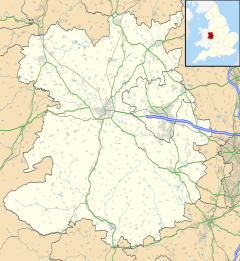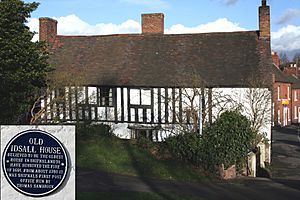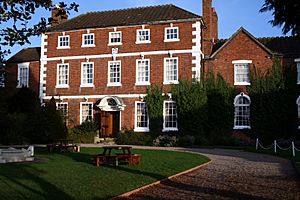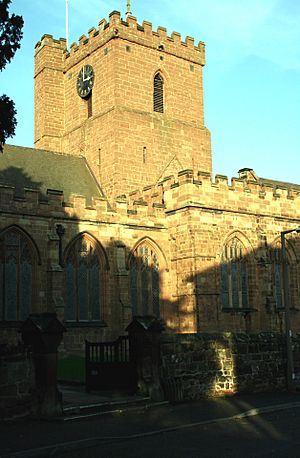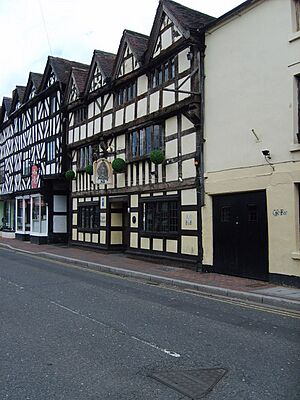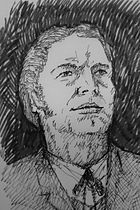Shifnal facts for kids
Quick facts for kids Shifnal |
|
|---|---|
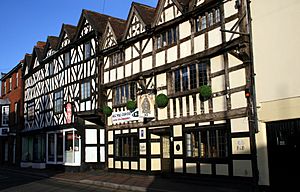 Market Place and Park Street |
|
| Population | 7,009 (2017) |
| OS grid reference | SJ7407 |
| Civil parish |
|
| Unitary authority |
|
| Ceremonial county | |
| Region | |
| Country | England |
| Sovereign state | United Kingdom |
| Post town | SHIFNAL |
| Postcode district | TF11 |
| Dialling code | 01952 |
| Police | West Mercia |
| Fire | Shropshire |
| Ambulance | West Midlands |
| EU Parliament | West Midlands |
| UK Parliament |
|
Shifnal is a busy market town and civil parish in Shropshire, England. It is about 4 miles (6.4 km) east of Telford and 17 miles (27 km) east of Shrewsbury. The town is close to the M54 motorway and the A5 road, also known as Watling Street. In 2011, Shifnal had a population of 6,776 people.
Contents
What's in a Name?
Shifnal's name might come from "Scuffanhalch," mentioned in an old document from the 9th century. Experts believe the first part of the name, "Shifnal," comes from a person's name, "Scuffa." The second part, "halh," means a valley. This describes the town's location in a valley.
Interestingly, the town's name has changed between Idsall and Shifnal over the centuries. Idsall means "Idi's nook" or corner. A "nook" was a small area of land. Some people think Idsall and Shifnal were names for two different settlements. One was on the east side of Wesley Brook, a small stream that runs through the town, and the other was on the west side. Over time, Shifnal became the main name for the whole town.
A Look Back in Time
Early Settlements
Shifnal likely started as an Anglian settlement around the end of the 7th century. The oldest parts of the town are thought to be around St Andrew's Church, Church Street, and Innage Road. Digs in these areas have found signs of very old buildings.
Norman Times
In 1086, the village was recorded in the Domesday Book, a famous survey ordered by William the Conqueror. The record shows that Robert, son of Theobald, held the land of Iteshale (Idsall) from Earl Roger. Before that, Earl Morcar, a Saxon, owned it but lost it after rebelling against the Normans.
St Andrew's Church has a Norman chancel (the part of the church near the altar). It was probably built on the site of an even older church. It used to be a special church called a minster, serving many smaller communities.
Medieval Growth
In 1245, Walter de Dunstanville, a local lord, asked King Henry III for permission to hold a market in the town. The King agreed, and Walter then created a wide market street. This area, east of the stream, became known as Shifnal. Slowly, this name became more common than Idsall.
Near Shifnal are the Caynton Caves, which are carved into sandstone. Local stories say they were made by followers of the Knights Templar hundreds of years ago. However, Historic England, a group that looks after old places, believes the caves were likely dug out in the late 1700s or early 1800s.
Tudor and Stuart Eras
Shifnal saw some early industry in the late 1500s. A blast furnace that used charcoal was built near the Manor House.
A big fire swept through Shifnal on July 7, 1591. It is thought a maidservant's candle accidentally set fire to some flax. The fire badly damaged many buildings east of Wesley Brook. The church was damaged, and its bells melted. The timber-framed Old Idsall House is said to be one of the few buildings that survived. A blue plaque on the house remembers this event. After the fire, Elizabeth I sent money to help the town rebuild.
Inside St Andrew's Church, there is a memorial for Mary Yates, also known as Nanny Murphy. She reportedly walked to London after the Great Fire in 1666, married her third husband when she was 92, and lived to be 127. There is a lane north of Shifnal named Nanny Murphy's Lane. Another memorial tablet records William Wakely, who was born in 1590 and lived through the reigns of eight kings and queens, dying in 1714.
In 2010, a special 16th-century wall painting style called Shropshire Scroll was found in a building on Broadway. This unique painting, about 2 meters by 2.5 meters, had been hidden for over a century. It is now on display at the Black Orchid hair salon.
18th and 19th Centuries
Aston Hall, built around 1720 on the east side of town, was home to people like George Austin and John Moultrie. These men owned large farms in America where tobacco was grown, using enslaved workers. George Austin was born in Shifnal in 1710. He became very wealthy in the colonies and later returned to Aston Hall. In 1766, Benjamin Priouleu, a "black servant to Mr Austin," was baptized in Shifnal. Later, in 1771, John Moultrie became a high-ranking official in Florida.
Thomas Beddoes, a famous doctor, was born in Shifnal in 1760. His home, Balcony House, was named for a room that stuck out above the roof. This building later became the Star Hotel.
Thomas Telford improved Watling Street, a main road that went through Shifnal, in the late 1700s. This road connected London to places like Shrewsbury and Chester. It brought a lot of business to the town.
Stagecoach services had been running through Shifnal since 1681. By 1829, 18 coaches a day passed through, making transport important for the town's economy. Travelers could rest at inns like the Jerningham Arms, the Star Hotel, and the Unicorn. However, when railways arrived in 1849, the coaching business quickly disappeared.
During this busy time, many new houses were built, giving Shifnal a Georgian look. The name Idsall was still used for the area around St Andrew's Church and the Manor House, separate from the market area of Shifnal.
A workhouse for the poor was built in Shifnal in 1817. It could hold up to 40 people. It was later expanded and became part of Shifnal Hospital before being turned into homes.
In 1855, a house used by the town's Catholic community for church services was burned down during a riot. Lord Stafford then built a new school and church for them in 1860. The school closed around 1917, but the building is still used as a church today.
The railway line from London and Birmingham to Holyhead was built through Shifnal in the late 1840s. A huge viaduct (a long bridge) was built to carry the railway over the marshy Wesley Brook valley. This viaduct divided the town. The original bridge was replaced in 1953 with a steel one. The railway opened on November 12, 1849, ending the stagecoach era.
The Shifnal Bank's Money Problems
In Victorian times, the Shropshire Banking Company, with its main office in Shifnal, faced big money problems. A director and some staff caused the bank to lose a lot of money, almost £244,000, which would be worth millions today.
The bank had started in 1836 and seemed to be doing well. However, in 1856, it had to write off a large amount of money due to unauthorized loans and other financial issues. One director, John Horton, had taken a large unauthorized loan. Later, the bank's manager, Allen, and his cashier, Gilbert, were found to have caused even bigger losses over ten years.
When police arrived to arrest Allen, he managed to get away. Gilbert shared information about his part in the problems and returned some money and investments. Allen, however, never returned the money he had taken.
The bank's directors tried to keep the full story quiet. Newspaper reporters were not allowed at a meeting with angry shareholders. The directors lent the bank a large sum of money to help it recover. The Shropshire Banking Company did recover and grew stronger, eventually being bought by Lloyds Bank in 1874.
20th and 21st Centuries
A brewery company was started near Shifnal in 1897, later becoming the Shifnal Brewery Company. It was eventually bought by Banks's of Wolverhampton in 1960. The Star Hotel was torn down after a fire in 1911.
The Eight Bells pub, now the Oddfellows Wine Bar, has a connection to Herbert James Pitchford, who died in the First World War. His name is on the war memorial in St Andrew's Church.
The railway bridge over Market Place was rebuilt in 1953. The town grew a lot during the 1960s. In 2015, plans were approved for over 1,100 new homes, meaning the town's population was expected to grow by 50% by 2020.
In 2009, Wrekin Construction, a large employer in the town, closed down. One of its assets was a large stone called the Gem of Tanzania, which was thought to be worth a lot of money. However, it turned out the stone's value had been greatly exaggerated, and it was later sold for much less.
In late 2018, plans for an even larger expansion of Shifnal were announced. These plans included up to 1,500 more homes and new business areas by 2036.
Culture and Fun
The Reliques of Ancient English Poetry, a famous collection of old songs and poems, was based on a manuscript found in Shifnal. Bishop Thomas Percy found the manuscript at his friend Humphrey Pitt's home in Shifnal. Pitt's maid was using the pages to light fires! Percy saved it and used many of the songs for his book.
Charles Dickens, a famous writer, visited Shifnal many times. Some people believe that the buildings in his book, The Old Curiosity Shop, were based on those in Shifnal. The Unicorn public house (later called Naughty Nell's) is thought to be the inspiration for the shop.
The diarist Hannah Cullwick (1833–1909) was born in Shifnal. She worked as a servant, and her diaries give a detailed look into the lives of working-class women in Victorian times. She is buried in St Andrew's churchyard.
Mary Arnold, a writer, went to boarding school in Shifnal. Her school days helped her write one of her novels, Marcella.
Many believe that Shifnal helped inspire P. G. Wodehouse's fictional town of Market Blandings, which is mentioned often in his Blandings Castle stories.
In 1968, the Shifnal Carnival was started. It's a fun event held on the last Saturday of June, with a funfair on the main street and a procession. In 2010, the Shifnal Festival was brought back after residents said they wanted a festival for arts and entertainment.
News and Travel
Local news and TV shows for Shifnal come from BBC West Midlands and ITV Central. You can listen to local radio stations like BBC Radio Shropshire and Hits Radio Black Country & Shropshire. The local newspaper is the Shropshire Star.
Getting Around
Buses run hourly from Monday to Saturday, connecting Shifnal to Telford, Cosford, and Wolverhampton. Other bus services also link to Bridgnorth.
The main railway station is on the line between Wolverhampton and Shrewsbury. You can catch trains to Shrewsbury, Telford, Wolverhampton, and Birmingham New Street.
| Route | Destination | Operator | Notes |
|---|---|---|---|
| 891 | Telford & Wolverhampton | Banga Buses | |
| 113/114 | Telford & Bridgnorth | Arriva Midlands North | |
| 115/116 | Weston Heath & Bridgnorth | Arriva Midlands North | |
| 809 | Rodbaston College | Select Bus Services | Schooldays only |
Places to Visit
Churches
- Church of England: St Andrew's Church on Church Street has a Norman chancel. It was extended around 1300 and has a special Elizabethan roof. It was almost certainly built where an older Saxon church once stood.
- Methodist: Trinity Church, Victoria Road
- Roman Catholic: St Mary's Church, Shrewsbury Road
Shifnal also has a Christian bookshop and drop-in center called Oasis, run by local churches working together.
Community Spots
The community library, run by the council, is on Broadway.
The Shifnal War Memorial Club, on Priorslee Road, is used for many events and by different groups. It opened in 1921 with a large recreation ground. It was rebuilt after a fire in 1982.
The Millennium Sensory Garden is between St Andrew's Church and Innage Road. It has a memorial for 13 soldiers from the First World War and 4 from the Second World War who are buried in the churchyard. Volunteers take care of the garden.
Shifnal Police Station, behind the library, closed in 2013. However, it reopened in August 2019 as a community cafe and gardens.
Sports
Shifnal has several sports facilities, including the Idsall Sports Centre, which is part of Idsall School. The school has had connections with famous football players from the nearby FA School of Excellence.
The town is home to many sports clubs, including:
- Table tennis
- Rugby
- Football
- Tennis
- Cricket
- Basketball
Shifnal Town FC plays in the West Midlands (Regional) League Premier Division league. Shifnal used to have a squash club and swimming pool, but these have closed and homes have been built there instead.
Shifnal Golf Club opened in 1913 with a nine-hole course.
Education
Shifnal has several pre-school nurseries and day centers. There are also two primary schools: Shifnal Primary School and St. Andrew's Church of England Primary School. For older students, there is Idsall School, a comprehensive secondary school, and Young Options College, a special independent secondary school.
Famous People from Shifnal
Many notable people have connections to Shifnal:
- George Talbot, 4th Earl of Shrewsbury (c. 1468–1538) – A nobleman.
- Edward Bromley (1563–1626) – A judge and politician who lived in Shifnal.
- Thomas Brown (1662–1704) – A satirist and poet born in Shifnal.
- Thomas Beddoes (1760–1808) – A doctor and writer who worked to treat diseases like tuberculosis.
- William Hollins (1763–1843) – An architect and sculptor.
- Henry Hill Hickman (1800–1830) – A surgeon and pioneer in using anaesthetics.
- Hannah Cullwick (1833–1909) – A nursemaid whose diaries give insights into Victorian life.
- Mary Augusta Ward (1851–1920) – A novelist who grew up in Shifnal.
- Peter Reynolds (1939–2001) – An archaeologist who was the first director of Butser Ancient Farm.
- Kevin Mulligan (born 1951) – A philosopher.
- Andrew Burn (born 1954) – A professor and media theorist.
- Stephen Harris (born 1968) – A music producer.
- Sam Owen (born 2003) – A mathematician.
Sports Stars
- William Kenyon-Slaney (1847–1908) – A footballer, cricketer, soldier, and politician. He was the first person to score in an international football match.
- Charlie Athersmith (1872–1910) – An international footballer who played mainly for Aston Villa.
- Edwin Bennett (1893–1929) – An English cricketer.
- Bert Williams (1920–2014) – An international football goalkeeper for Wolverhampton Wanderers.
- Reg Attwell (1920–1986) – A professional footballer.
- Jack Taylor (1930–2012) – A famous football referee who lived in Shifnal.
- Peter Alan Baker (born 1967) – An English professional golfer.
- Peter Lamsdale (born 1971) – An English cricketer.
Images for kids
See also
 In Spanish: Shifnal para niños
In Spanish: Shifnal para niños


